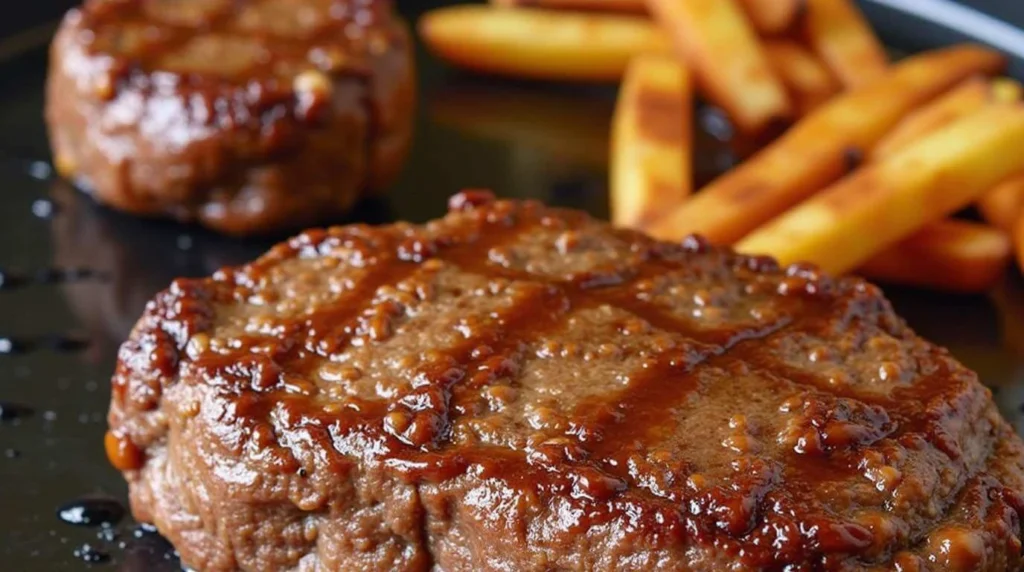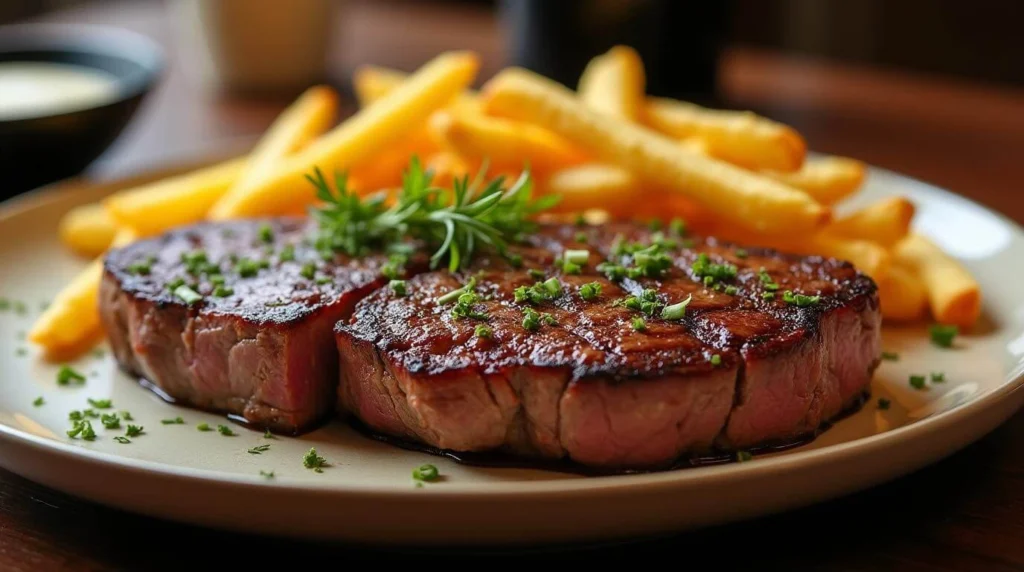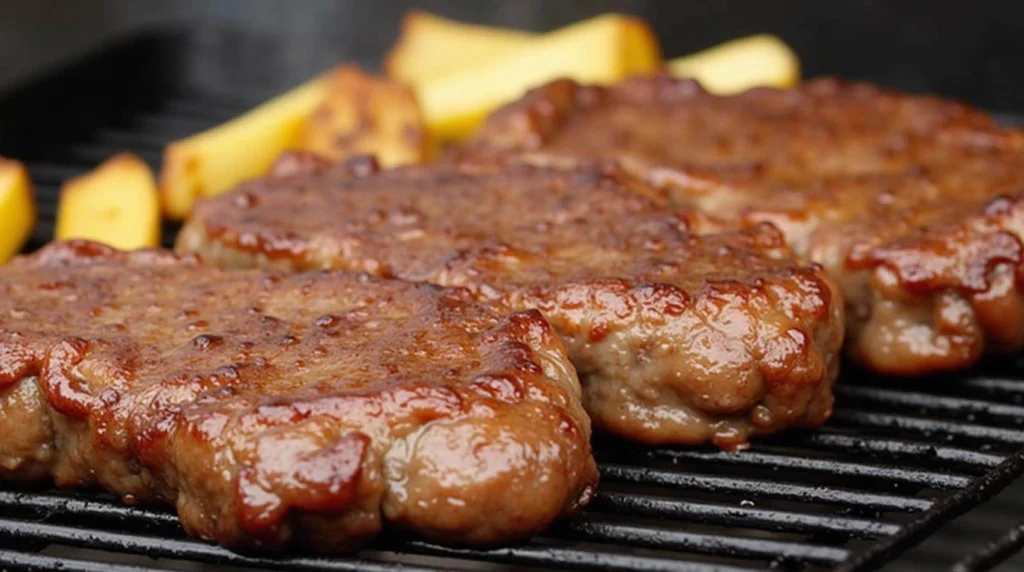What Is Steak Frites?
Steak Frites, pronounced “Steak Frites,” is a classic dish that has captured the hearts and taste buds of food lovers around the world. Originating in France, this timeless meal pairs a perfectly cooked steak with golden, crispy French fries, creating a harmonious blend of rich, savory flavors and satisfying textures. Known for its simplicity and elegance, Steak Frites is a staple of French bistros and a go-to comfort food for many.
In this article, we’ll explore the origins of Steak Frites, what makes it so beloved, and how you can enjoy or prepare this iconic dish in all its mouthwatering glory. Whether you’re a seasoned food enthusiast or just discovering French cuisine, Steak fries are a dish worth savoring.
My culinary journey began in a small Parisian bistro. There, the sound of a steak sizzling and the crunch of French fries turned a simple meal into something special. Steak Frites, a true French bistro classic, is more than just food—it’s a celebration of simplicity and elegance.
This iconic dish is loved in France and Belgium for its perfect mix of tender beef and crispy potatoes. It serves 4 and needs about 95 minutes to cook 1. Steak frites have won the hearts of cooks and food lovers everywhere.
Join me on this journey into the world of steak frites. We’ll explore its history, cooking methods, and how to make it like a pro in your kitchen. This guide is for everyone, whether you’re an experienced cook or just starting.
Table of Contents
Understanding the French Bistro Classic
Steak frites are a true culinary delight at the heart of French food. It’s a dish deeply rooted in Parisian bistros, showing the true spirit of French cooking. The word “bistrot” started in 19th-century Paris. It’s a dining concept loved by many around the world.
Origins and Cultural Significance
The story of steak frites is part of France’s rich food history. In Parisian bistros, it became a favorite dish. It shows the beauty of French cooking in its simplest form.
This dish is loved for its tasty steak and crispy French fries. Together, they make a meal that fills both your belly and your heart.
Traditional Serving Methods
How bistros serve steak frites is key to its charm. It usually comes with:
- A fresh green salad
- Sauce béarnaise
- Seasoned French fries
Regional Variations
France’s different areas have their twist on steak frites. While the main parts stay the same, local flavors make each dish unique. Enjoying steak frites in a Parisian bistro is a special experience.
| Region | Unique Characteristic |
|---|---|
| Paris | Classic preparation with béarnaise sauce |
| Normandy | Often served with local butter sauce |
| Provence | Accompanied by herbes de Provence seasoning |
“Steak frites is more than just a meal; it’s a culinary journey through French dining tradition.”
Steak frites are a treat for food lovers and experts alike. It gives a taste of France’s rich food history.
Essential Components of Steak Frites
Steak frites is a perfect mix of a juicy beef cut and crispy French fries. Choosing the right beef tenderloin and making great French fries are key to a great meal.
Choosing the right beef is key for a great steak frites. While ribeye and beef tenderloin are favorites, you can try other cuts too. Some great options include:
- Sirloin steak
- Beef tenderloin
- Flank steak
For the best French fries, follow these tips:
- Use Russet potatoes for the crispiest fries
- Soak potato slices in cold water for 30 minutes
- Fry in two stages: first at 300°F for 6 minutes, then at 380°F for 5 minutes
“The secret to great steak frites lies in the quality of your ingredients and precise cooking techniques.”
Cooking temperatures are important for the perfect steak. For a medium-rare beef tenderloin, cook it to 130-135 degrees Fahrenheit. This makes the steak juicy and flavorful, perfect with crispy French fries.
Selecting the Perfect Cut of Beef
Choosing the right beef cut is key for seared perfection in your steak frites. Your dining experience greatly depends on knowing the differences in beef cuts.
Premium Cut Options
For a top-notch dining experience, look at these premium beef cuts:
- Ribeye: Known for rich marbling and intense flavor
- Beef tenderloin: Extremely tender with minimal muscle usage
- Strip steak: Balanced fat content providing juicy texture
Budget-Friendly Alternatives
For tasty options without spending a lot, try these cuts:
- Flank steak: Quick-grilling and flavor-absorbing
- Chuck eye steak: Widely available and affordable
- Flatiron steak: Tender when cooked to medium rare
Meat Quality Considerations
Choosing high-quality meat is essential for the best-seared perfection. Keep these factors in mind:
| Cut Category | Marbling | Cooking Method |
|---|---|---|
| Rib Cuts | High marbling | Grilling, roasting |
| Loin Cuts | Moderate marbling | Pan-searing |
| Round Cuts | Low marbling | Slow cooking |
Pro tip: Always choose meat with consistent marbling for the best gastronomic experience.

The Art of French Fry Preparation
Making crispy fries is key to mastering steak frites. The double-frying method turns regular potatoes into golden, crunchy treats. These fries are perfect with your steak.
Choosing the right potatoes is very important. Russet potatoes are best for a crispy outside and fluffy inside. Before cooking, prepare your potatoes well:
- Wash and peel potatoes thoroughly
- Cut into uniform, even strips
- Soak in cold water for 15-30 minutes to remove excess starch
The secret to crispy fries like in restaurants is the double-frying method. Here’s how to do it:
- First fry: Heat oil to 250-325°F
- Second fry: Increase temperature to 375°F for ultimate crispiness
| Frying Stage | Temperature | Purpose |
|---|---|---|
| First Fry | 250-325°F | Create a crispy exterior |
| Second Fry | 375°F | Create crispy exterior |
Pro tip: Use a reliable thermometer that measures up to 400°F to ensure precise oil temperatures. This attention to detail will make your French fries truly extraordinary.
“Perfect fries are an art form that requires patience and precision” – Chef’s Wisdom
Cold-Start Frying Technique
Learning to make perfect French fries is all about mastering new cooking techniques. The cold-start frying method is a game-changer. It changes how we make crispy potato sides.
This method starts by adding raw potato sticks to oil that’s not too hot yet. This makes fries with a unique texture. It’s great for home cooks who want to improve their potato dishes.
Benefits of Cold-Start Frying
- Reduces oil splatter dramatically
- Uses significantly less cooking oil
- Ensures even cooking throughout the potato
- Eliminates multiple frying sessions
Temperature Control Tips
Controlling the temperature is key. Start with about three cups of oil for every pound of potatoes. Heat the oil slowly to around 325 degrees Fahrenheit.
Oil Selection Guide
Use a heavy cast-iron pot or Dutch oven for better heat retention. Vegetable or peanut oil is best for consistent results. Remember, soaking cut potatoes in cold water helps prevent sticking.
“Cooking is about passion, so it may look slightly temperamental in a way that it’s too assertive to the naked eye.” – Gordon Ramsay
Mastering the Perfect Steak Sear
Getting a perfect sear on a steak is an art. It turns a simple steak into a dish fit for a restaurant. Your skills in cooking can make all the difference between a great meal and an okay one.
Start by picking a top-notch steak. Then, dry the meat well for the best sear. Here are the main steps for a perfect search:
- Bring the steak to room temperature before cooking
- Use a cast-iron pan heated to medium-high
- Season generously with coarse salt and pepper
Focus on making a great crust. Sear each side for 4-5 minutes. Here’s a guide for the perfect internal temperature:
| Doneness | Temperature |
|---|---|
| Rare | 46-49°C |
| Medium-Rare | 50-53°C |
| Medium | 54-59°C |
Pro tip: Take the steak off heat 6-8°C before your final temperature to rest. Let it rest for 5-8 minutes. This helps the juices stay inside, and the meat relaxes.
“The secret to a perfect steak is patience and precise temperature control.”
Whether you like a ribeye or another cut, learning these techniques will make your steak frites amazing.

Classic Sauce Pairings
Take your steak frites to the next level with the perfect sauce. Discover the world of French sauces that make your meal a gourmet delight.
Béarnaise Sauce: A French Culinary Treasure
The béarnaise sauce is a must-have for steak frites. It’s a mix of clarified butter, egg yolks, and white wine vinegar. Here’s how to make it:
- Start with 4 tablespoons of white wine vinegar
- Add 1 cup of melted unsalted butter
- Enhance with fresh herbs for extra taste
Green Peppercorn Sauce Exploration
Looking for something different? Try the green peppercorn sauce. It has a unique taste and an interesting nutritional profile:
| Nutritional Content | Amount | % Daily Value |
|---|---|---|
| Calories | 109 | – |
| Fat | 7.4g | 11% |
| Saturated Fat | 4.6g | 29% |
Alternative Sauce Options
Try these exciting sauces to mix things up:
- Creamy Mustard Sauce – A tangy match for your steak
- Coconut Curry Sauce – For a unique flavor
- Classic Compound Butter – A French touch
Pro tip: The right sauce can turn your steak frites into a true culinary delight!
Remember, finding the perfect sauce is all about balance. Try different ones to find your favorite and make your steak frites even better.
Kitchen Equipment Essentials
Mastering steak frites needs the right kitchen tools. These tools can make your cooking better and more like a restaurant’s.
- Heavy-duty cast-iron skillet for perfect steak searing
- Deep fryer or heavy-bottomed pot for crispy fries
- Meat thermometer for precise temperature control
- Sharp chef’s knife for meat preparation
Your kitchen should have tools for different cooking methods. Stainless steel is best, as 83% of pros like it for being durable and easy to clean.
| Equipment | Purpose | Recommended Type |
|---|---|---|
| Skillet | Steak Searing | Cast Iron |
| Thermometer | Temperature Control | Digital Instant-Read |
| Fryer | French Fry Preparation | Deep Heavy-Bottomed Pot |
Quality kitchen tools can boost your cooking skills. Professional chefs know that equipment is as important as a technique for dishes like steak frites.
“The right tool can make all the difference between a good meal and an exceptional one.”
About 75% of pro kitchens focus on energy-efficient and versatile gear. Pick tools that do more than one thing. They’ll help you grow your cooking skills with confidence.
Timing and Coordination Tips
Creating the perfect steak frites needs precision and understanding of your cooking. Mastering timing can make your meal go from good to great.
Strategic Preparation Schedule
Success with steak frites comes from careful planning. Here’s a simple plan to follow:
- Prepare your ingredients before starting to cook
- Season steak 30 minutes before cooking
- Start potato preparation first
- Rest the meat immediately after searing
Service Temperature Guidelines
Temperature control is key for a great dining experience. You want both parts hot and fresh:
- Steak should rest at room temperature before cooking
- Keep fries warm in a low-temperature oven
- Plate immediately after final preparation
“The secret to perfect steak frites is synchronization and precision.” – French Culinary Experts
Professional chefs suggest using a kitchen timer and keeping your workspace tidy. This ensures everything is ready at the same time. It keeps your cooking techniques sharp and enhances your dining experience.
Common Cooking Mistakes to Avoid
Mastering steak frites means avoiding key cooking mistakes. Knowing these errors can make your cooking look like a pro’s. It’s all about the details.
- Overcrowding the pan prevents proper steak searing, leading to steamed instead of caramelized meat.
- Not allowing the meat to reach room temperature before cooking compromises even heat distribution
- Incorrect seasoning timing can negatively impact the meat’s moisture and flavor profile
Temperature control is key in cooking. Chefs say specific temperatures are needed for the perfect steak:
| Doneness Level | Temperature |
|---|---|
| Rare | 125°F (51°C) |
| Medium-rare | 135°F (57°C) |
| Medium | 145°F (63°C) |
| Well-done | 160°F (71°C) |
Your frying technique is very important. The pan should be so hot that it begins smoking before adding meat. This ensures a great crust and flavor. Cooking times depend on the steak’s thickness. Usually, it takes 30 seconds per side and more oven time for the right doneness.
“Mastering steak frites is about precision, not perfection.”
By learning these fine points, you’ll make your steak frites truly special.
Wine Pairing Suggestions
Adding the right wine to your steak frites can make it a special treat. It’s all about matching the wine’s taste with the dish’s richness.
Many think red wines are best with beef. But Master Sommelier Jack Mason says white wines can also pair well with steak.
- Recommended Red Wines:
- Cabernet Sauvignon
- Bordeaux blends
- Syrah from Rhône Valley
Some white wines can also match steak perfectly. Mason likes leaner whites like Riesling or dry Chenin Blanc for tender cuts.
| Wine Type | Best Steak Cut | Flavor Profile |
|---|---|---|
| Barrel-aged Chardonnay | Various cuts | Medium to full-bodied |
| Hermitage Blanc | Rib eye | Rich and complex |
When picking your wine, think about these key points:
- Match the wine with the steak’s cooking style
- Stay away from heavy sauces that might fight with the wine
- Go for medium-rare or less-cooked steaks for the best wine match
The art of wine pairing is about creating harmony between food and drink, transforming a simple meal into an unforgettable experience.
Pro tip: 75% of diners say good wine makes their meal better. So, take your time, try new things, and find your favorite wine for steak frites!
Plating and Presentation Techniques
To make your steak frites a true culinary delight, it’s not just about cooking. How you present it is key. It turns a simple dish into a feast for the eyes.
Visual Appeal in Steak Frites Presentation
Plating is an art, and chefs know it. 70% of diners think presentation affects taste and quality. To impress, focus on these:
- Balance of colors and textures
- Steak and fries placement
- How do you add sauce
Traditional Bistro Styling
In a Parisian bistro, steak frites are simple yet elegant. 75% of top restaurants focus on sauce presentation. The classic way is:
- The steak is placed off-center
- Fries are arranged neatly
- The sauce is drizzled artfully
Modern Plating Techniques
Today’s chefs are making steak frites look new. 85% of chefs say garnishing is key. Try these modern ideas:
| Technique | Description |
|---|---|
| Sauce Smearing | Make sauce trails on the plate |
| Herb Garnishing | Add fresh herbs for color and taste |
| Color Coordination | Choose plate and food colors wisely |
60% of diners prefer dishes that look good. Your presentation can make a meal unforgettable.

Making Restaurant-Quality Steak Frites at Home
To make perfect steak frites at home, you need to learn special cooking skills. These skills turn simple ingredients into a meal fit for a French bistro. The goal is to get a seared steak and crispy fries, just like the pros.
Start by picking the right ingredients and timing. Choose steaks that are 1 to 1.5 inches thick and weigh about 2 pounds in total. Look for cuts like onglet, tri-tip, or flank steak for great taste.
- Recommended steak resting time: 1 hour before cooking
- Cooking time per steak side: 3 minutes for medium-rare
- Potato preparation: Soak for 2 hours to overnight
The cold-start frying method is a game-changer for home cooks. It uses 6 cups of oil, less than traditional deep frying. This method cuts down on splatters and lets you cook the sauce at the same time.
| Cooking Stage | Temperature | Duration |
|---|---|---|
| First Potato Fry | 275°F | Initial stage |
| Final Potato Fry | 375°F | Crisp finish |
Your prep time will be about 95 minutes. This includes getting everything ready, cooking, and resting. Keep an eye on the temperature and timing for top-notch results.
Pro tip: The secret to seared perfection is patience and precise heat management.
With practice, your kitchen will become a French bistro. You’ll master the art of making steak frites at home.
Variations on the Classic Recipe
Expanding your cooking skills means trying new things with old favorites. Steak frites are a great dish to play with, adding your twist. By using different ingredients and methods, you can make this classic dish your own.
- Meat Variations:
- Sirloin steak for a leaner option
- Flank steak for a more intense flavor
- Filet mignon for ultimate tenderness
- Fry Innovations:
- Garlic Parmesan frites
- Truffle-seasoned potatoes
- Sweet potato alternative
- Herb butter-topped fries
Choosing the right sauce can change how you enjoy steak frites. Try green peppercorn sauce, chimichurri, or a bold red wine reduction. Each one adds a special flavor that can make your dish stand out.
Pro tip: Don’t be afraid to experiment and make the recipe your own!
When trying new things, keep the basics right. Use the right searing temperatures, let the meat rest, and season well. Your cooking skills will show in how you improve the classic dish.
For a bold twist, try something like Peppercorn-Crusted steak. Or add international spices that match the meat and fries. It’s a fun journey of flavors.
Storage and Reheating Guidelines
Keeping your steak frites tasty means storing and reheating them correctly. Learning these skills lets you enjoy your meal again later.
Proper Storage Techniques
Here’s how to keep your steak frites fresh:
- Separate steak and fries before refrigerating
- Store in airtight containers
- Refrigerate within two hours of cooking
- Consume within three to four days
Smart Reheating Methods
Reheating steak needs care to keep it tender and tasty. Try different ways to make it taste new.
- Sous Vide Method: This method keeps moisture and flavor best.
- Reheating time: About 5 minutes
- Quality rating: 8/10
- Oven Technique:
- Preheat to 250°F
- Place the steak on a wire rack.
- Heat until internal temperature reaches 110°F
- Stovetop Searing:
- Reheating time: 3-5 minutes
- Quality rating: 4/10
When reheating, safety is key. The USDA says to heat to 165°F to kill bacteria. Don’t use slow cookers or steam tables, as they can be too warm.
Pro tip: Let your steak sit at room temperature for about 30 minutes before reheating to ensure even warming.
Conclusion
Learning to make a French bistro classic like steak frites can make your cooking special. It turns a simple dish into a memorable meal that shows off French cooking. By mastering how to sear a steak and make crispy fries, you open up a world of taste and tradition.
Steak frites is all about being simple yet flexible. You can pick from ribeye, sirloin, or filet mignon, and add your own to the frites. Pair it with wine like Cabernet Sauvignon and finish with desserts like Crème brûlée for a full meal.
Exploring steak frites is more than cooking—it’s diving into a rich culinary tradition. Keep practicing, try new things, and most importantly, have fun making a top-notch meal at home.
FAQ
What exactly is steak frites?
Steak frites is a French dish with a seared steak and crispy fries. It’s a simple yet iconic dish that shows the heart of French cuisine. It’s often served with béarnaise sauce in Parisian restaurants.
What is the best cut of beef for steak frites?
Beef tenderloin, ribeye, and strip steak are top choices for steak frites. But hanger steak or flank steak can also be great, depending on your taste and cooking skills.
How do I achieve perfectly crispy French fries?
For crispy fries, use the double-frying method. Choose starchy potatoes like Russet, cut them evenly, and fry them twice. First, it is cooked at a lower temperature inside, then at a higher temperature for a crispy outside.
What is the ideal way to sear a steak?
To sear a steak well, start by letting it come to room temperature. Pat it dry and use a hot cast-iron skillet. Cook at high heat, flipping often and basting with butter for a delicious crust and juicy steak.
What sauce traditionally accompanies steak frites?
Béarnaise sauce is the classic choice for steak frites. It’s a rich sauce made with egg yolks, white wine vinegar, shallots, and tarragon. Green peppercorn sauce is also a popular choice.
How can I pair wine with steak frites?
Full-bodied red wines like Cabernet Sauvignon, Malbec, or Bordeaux blends pair well with steak frites. These wines complement the steak’s rich flavors, making the meal even better.
Can I make steak frites at home?
Yes, you can make steak frites at home! Use a cast-iron skillet, a meat thermometer, and a proper frying setup. Focus on quality ingredients, cooking techniques, and timing for a restaurant-quality dish.
How should I store and reheat leftover steak frites?
Store steak and fries separately in airtight containers in the fridge. Reheat the steak gently to avoid overcooking. Crisp the fries in an oven or air fryer. It’s best to eat it within 1-2 days for the best flavor and quality.


Comments are closed.